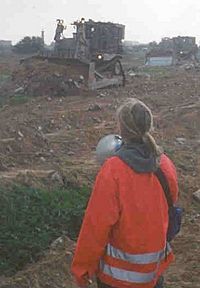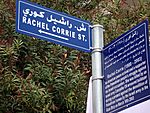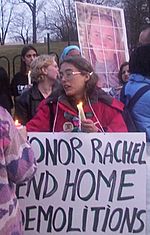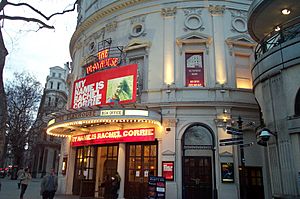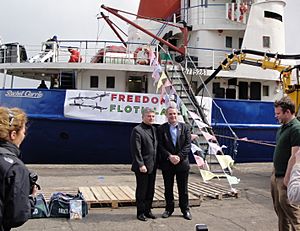Rachel Corrie facts for kids
Quick facts for kids
Rachel Corrie
|
|
|---|---|
 |
|
| Born |
Rachel Aliene Corrie
April 10, 1979 Olympia, Washington, U.S.
|
| Died | March 16, 2003 (aged 23) Rafah, Gaza Strip
|
| Alma mater | Evergreen State College |
Rachel Aliene Corrie (born April 10, 1979 – died March 16, 2003) was an American activist. She was a member of the International Solidarity Movement (ISM), a group that supports Palestinians. Rachel died in the Gaza Strip during a time of conflict called the Second Intifada. The exact reasons for her death are still debated.
Rachel went to Gaza as part of her college studies. She wanted to create a "sister city" connection between her hometown, Olympia, Washington, and Rafah in Gaza. While there, she joined other ISM activists. They tried to stop the Israeli army from demolishing Palestinian homes. Israeli authorities said these demolitions were to find weapons tunnels. However, some human rights groups said they were a form of collective punishment.
Rachel's Early Life
Rachel Corrie was born on April 10, 1979, in Olympia, Washington, United States. She was the youngest of three children. Her parents were Craig and Cindy Corrie. Cindy described their family as "average Americans" who were politically liberal and economically conservative.
After finishing Capital High School, Rachel went to The Evergreen State College in Olympia. She studied arts there. She also took a year off to volunteer with the Washington State Conservation Corps. The ISM says she also visited mental patients weekly for three years.
While at Evergreen State College, Rachel became a strong peace activist. She organized peace events with a local group called "Olympians for Peace and Solidarity." Later, she joined the International Solidarity Movement (ISM). She wanted to protest the actions of the Israeli army in the West Bank and Gaza Strip. For her final year of college, she planned a project to travel to Gaza. There, she would join the ISM and start a "sister city" project between Olympia and Rafah. Before leaving, she also set up a pen-pal program for children in Olympia and Rafah.
Rachel's Work in Palestine
In Rafah, Rachel Corrie often stood in front of armored bulldozers. She hoped to stop the demolition of homes. These demolitions were common near the border between Israel and Egypt in Rafah. They were done to find bombs and destroy tunnels used to smuggle weapons. Some human rights groups criticized these actions as "collective punishment." Israeli authorities said the demolitions were needed because Palestinian gunmen used the buildings to shoot at their soldiers or hide tunnels. Rachel was one of about eight activists from other countries. They tried to stop the Israeli army by acting as human shields.
On her first night in Rafah, Rachel and two other ISM members camped in an area called Block J. The ISM said this area was often targeted by gunfire from an Israeli watchtower. By standing visibly between Palestinians and Israeli snipers, they hoped to stop the shooting. They held banners saying they were "internationals." When Israeli soldiers fired warning shots, Rachel and her friends took down their tent and left.
Some Palestinian militants worried that the "internationals" might get caught in crossfire. Other residents worried the activists might be spies. To build trust, Rachel learned some Arabic words. She also took part in a mock trial that criticized the Bush Administration. The ISM members eventually received food and housing. However, a letter was passed around Rafah that made people suspicious of them. On the morning Rachel died, they planned to change these feelings. One activist said, "We all had a feeling that our role was too passive. We talked about how to engage the Israeli military."
Protecting Water Wells
In the last month of her life, Rachel spent a lot of time at the Canada Well. She helped protect Rafah municipal workers who were fixing damage to the well. Israeli bulldozers had damaged it. The Canada Well and El Iskan Well provided over half of Rafah's water before they were damaged. The city had been limiting water use since then. Another ISM activist, Gordon Murray, wrote that ISM activists stayed there because "Israeli snipers and tanks routinely shot at civilian workers trying to repair the wells." Rachel wrote that her group had permission from the Israeli District Command Office. They also carried banners and megaphones. Still, she said, "the activists and workers were fired upon several times over a period of about one hour. One of the bullets came within two metres of three internationals and a municipal water worker."
Rachel's Emails from Gaza
Rachel Corrie sent emails to her mother while she was in Gaza. Four of these were later published by The Guardian. In 2008, a book called Let Me Stand Alone was published. It included her emails and other writings. The play My Name is Rachel Corrie and a musical piece called The Skies are Weeping were based on Rachel's letters.
Reactions to Rachel's Death
Rachel's death caused a lot of discussion and was reported by news outlets around the world.
Her Parents' Reaction
Rachel's father, Craig Corrie, said that the bulldozer driver was responsible. He said, "you're responsible for knowing what's in front of your blade... It's a no brainer that this was gross negligence." He also said that the Israeli army "had three months to figure out how to deal with the activists that were there."
Political Responses
In March 2003, U.S. Representative Brian Baird asked the U.S. Congress to investigate Rachel's death. The Congress did not act on this request. Rachel's family joined Representative Baird in asking for a U.S. investigation.
Yasser Arafat, who was the first President of the Palestinian Authority, offered his sympathy. He gave the "blessings of the Palestinian people" to Rachel. He also promised to name a street in Gaza after her. Rachel's mother, Cindy Corrie, said that Arafat told Craig Corrie that Rachel "is your daughter but she is also the daughter of all Palestinians."
In August 2012, U.S. Ambassador to Israel Dan Shapiro said that the Israeli investigation was not good enough. He said it was not thorough or clear enough.
Human Rights Groups' Views
Amnesty International asked for an independent investigation. Christine Bustany, their director for the Middle East, said that U.S.-made bulldozers were being used as weapons. She said their transfer to Israel should stop.
In 2005, Human Rights Watch questioned how fair and professional the Israeli army's investigation was. They noted problems like investigators not being prepared. They also asked "hostile" questions and did not seem interested in comparing what soldiers and other witnesses said.
NGO Monitor, an Israeli group, criticized other NGOs. Its president, Gerald Steinberg, said that Rachel's death was "entirely unnecessary." He added that the leaders of the ISM were largely to blame for her death.
Media Coverage
The Observer newspaper suggested that Rachel's death got more attention because she was American. They noted that nine Palestinians, including a four-year-old girl, died in Gaza on the same night.
Her Parents' Activities
Since Rachel's death, her parents, Cindy and Craig, have worked to "promote peace." They also try to raise awareness about the difficulties faced by Palestinians. They continue what they believe was Rachel's work. The Corries have created the "Rachel Corrie Foundation for Peace and Justice." They have also started projects to remember their daughter. They have also pushed for more investigation into the incident.
Rachel's parents have visited the region many times. They have been to Gaza twice. They saw the place where she died and met ISM members and Palestinians she knew. They also visited Ramallah in the West Bank. There, Yasser Arafat met them and gave them a plaque in Rachel's memory.
In June 2005, the Nasrallah family, whose home Rachel was trying to protect, toured the United States with the Corries. They aimed to raise money to rebuild the Nasrallah home and other homes destroyed in Rafah.
Memorial Events
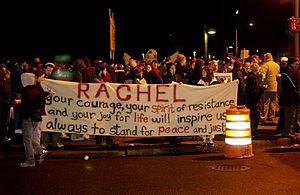
After Rachel's death, posters and graffiti praising her appeared in Rafah. One graffiti message said, "Rachel was an American citizen with Palestinian blood." The day after she died, about 30 American and European ISM activists and 300 Palestinians protested at the spot where she was killed.
In 2008, Rachel's parents marked the fifth anniversary of her death in Nablus, a town in the West Bank. About 150 Palestinians and others joined them to dedicate a memorial to Rachel on one of the city's streets.
In 2011, Iran named a street in Tehran after Rachel Corrie.
Artistic Tributes
In 2004, Alaska composer Philip Munger wrote a musical piece called a cantata about Rachel Corrie. It was called The Skies are Weeping.
In 2005, My Name is Rachel Corrie, a play based on Rachel's journals and emails, was shown in London. It was put together by actor Alan Rickman and journalist Katharine Viner. The play was later performed in ten countries, including Israel.
Singer Billy Bragg wrote a song about Rachel's death called "The Lonesome Death of Rachel Corrie." Irish music group Kíla also included an instrumental song called "Rachel Corrie" on their 2015 album.
In 2003, Pittsburgh singer Mike Stout wrote a song about Rachel Corrie. David Rovics also wrote a song called The Death of Rachel Corrie in 2003.
MV Rachel Corrie Ship
On March 30, 2010, a ship was bought in Ireland by the Free Gaza Movement. It was named in honor of Rachel Corrie. The ship was meant to join a group of ships trying to break the blockade of the Gaza Strip. The other ships were stopped, but the MV Rachel Corrie continued towards Gaza alone. The Israeli navy stopped the ship on June 5, 2010. The ship was then taken to the port of Ashdod. There, its cargo was inspected and sent by land to Gaza.
Symbolic Gravestone in Iran
On the twelfth anniversary of Rachel's death, a symbolic gravestone with her name was placed in the Tehran cemetery in Iran. It was put there to honor her. Near her symbolic gravestone are twelve other symbolic gravestones.
See also
 In Spanish: Rachel Corrie para niños
In Spanish: Rachel Corrie para niños
- ISM casualties in Palestine and Israel
- List of peace activists
Images for kids


